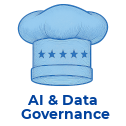Governance Failure Pattern #4: No Clear Ownership
Let’s talk about the ghost town.
You know the one.
It’s filled with abandoned dashboards, forgotten glossaries, and metadata artifacts that no one maintains.
Lineage diagrams that haven’t been updated since the last reorg.
Quality scores that live in a spreadsheet no one opens.
Model documentation that exists… somewhere.
This is what happens when governance lacks ownership.
Everyone assumes someone else is responsible.
And so, no one is.
The Governance Ghost Town
It’s not that the artifacts don’t exist.
They do.
They were created during a workshop, a sprint, or a compliance push.
But without clear ownership, they become orphaned.
- Metadata is published, but never curated
- Lineage is mapped, but never validated
- AI models are documented, but no one checks if they’re still in use
Governance becomes a passive archive instead of an active capability.
And when something breaks, when a model fails, when a definition is disputed, when a dashboard misleads – there’s no one to call.
Why This Happens
Most governance programs focus on what needs to be done:
Create a glossary. Map the lineage. Document the model.
But they skip the who.
They assume ownership will emerge organically.
It won’t.
Without explicit roles, governance becomes a shared responsibility that no one actually shares.
What to Do Instead: Build a Governance Brigade
Governance needs more than artifacts.
It needs accountability.
Start by building a governance brigade, a cross-functional team with clearly defined roles:
- Data Stewards who own business definitions and quality thresholds
- AI Risk Leads who track model documentation, drift, and ethical guardrails
- Metadata Owners who maintain lineage, glossary terms, and technical context
Make ownership visible.
Make it intuitive.
Make it sticky.
Visual metaphors work.
Have a little fun with it. Make up icons or other visuals that can be used to tag governance facets and roles. A chef’s hat for stewards, quality badges to indicate items that have been reviewed and approved.
They turn abstract roles into recognizable personas.
They help stakeholders understand who’s responsible for what, and why it matters.
When someone sees a chef’s hat icon next to a glossary term, they know who’s accountable.
When a dashboard has a quality badge, they know it has been vetted and is reliable.
Ownership becomes part of the interface, not just the org chart.
Final Thought: If Everyone Owns It, No One Does
Governance without ownership is like a kitchen without chefs.
Ingredients pile up. Recipes go stale.
And the meal never gets served. So assign the hats.
Define the roles.
And make sure your governance kitchen has a brigade that knows exactly what’s on the menu.

